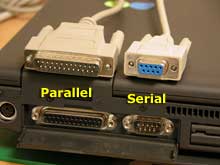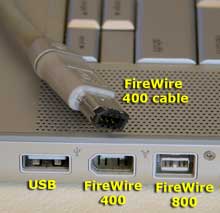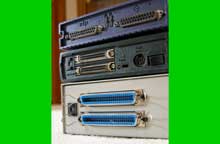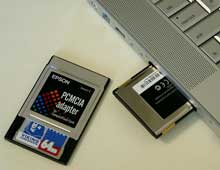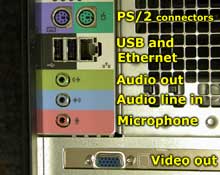Ports and Peripherals
Links to topics on this page:
Peripherals are devices that are attached to a computer system to enhance its capabilities. Peripherals include input devices, output devices, storage devices, and communications devices.
All peripherals must have some way to access the data bus of the computer (the communications channel on the motherboard that connects the processor, RAM, and other components). To do this, peripherals are connected via some kind of port (also called a I/O port, for input/output) on the computer (and a cable with the proper connectors is needed).
In some cases, the controller chips and circuitry for a port may be included on the motherboard itself (especially in laptop computers). In other cases, an expansion card in one of the expansion slots on the motherboard provides the needed port. This card is also called a controller card or an interface card. The software needed to handle the interface through the controller card is called a device driver, a type of system software.
A video card that allows output to be sent to a monitor is an example of an interface card. The part of the video controller card that protrudes through the case of the computer includes a port (or ports) that monitor cables can connect to.
Let’s look at some of the kinds of ports used on personal computers.
Serial Port
Serial
Parallel
USB
FireWire
SCSI
PCMCIA
Ethernet
Other
A serial port transmit data one bit at a time. Typically on older PCs, a modem, mouse, or keyboard would be connected via serial ports. Serial cables are cheaper to make than parallel cables and easier to shield from interference.
Parallel Port
The parallel port of older PCs could transmit 8 bits of data at a time, so it was faster than the old serial port (just as more traffic can move along a multi-lane highway than can move along a one-lane road). The parallel port was typically used to connect a printer to the computer.
USB port
Parallel and Serial ports on the back of a PC laptop
(click for larger image)
USB (Universal Serial Bus) is a newer type of serial connection that is much faster than the old serial ports. USB is also much smarter and more versatile since it allows the “daisy chaining” of up to 127 USB peripherals connected to one port.
USB ports can support the connection of many kinds of devices (keyboard, mouse, printer, audio in/out, external floppy or Zip drives, scanner, flash drive, etc.). Newer PCs and Macs include several USB ports, some often located in handy spots on the front panel of the computer case or the side of the keyboard. USB connections are hot-swappable (they can be connected and disconnected while the devices are turned on; this is not always true for older connection methods).
An updated version, called USB 2.0 has a speed of 480 Mbits/sec, which is 40 times faster than the older USB port’s high-speed mode (the connectors look the same).
FireWire (IEEE 1394)
USB port on the side of a PowerBook.
(click for larger image)
FireWire is a high speed interface that was developed by Apple computer. Sony uses a version called i.Link. It is often called IEEE 1394 when used on PCs (since Apple charges an extra fee for using the name “FireWire”). The first version of FireWire (FireWire 400) works at speeds of 400 Mbits/sec, and the newer FireWire 800 supports twice that speed. FireWire is hot-swappable and supports up to 63 daisy-chained peripherals per port.
FireWire works especially well for digital video and audio (from a digital camcorder) as well for connecting external hard drives or other high-bandwidth peripherals. The FireWire connection can also supply 60 watts of power to the peripheral.
SCSI
FireWire connectors
(click for larger image)
SCSI (Small Computer System Interface), pronounced “scuzzy,” is an older high-speed interface technology. Up to six devices can be daisy-chained to a SCSI port on your computer, but, unlike the plug-and-play nature of USB and FireWire, the user must manually set the SCSI ID number of each device and add connection terminators as needed. In other words, it was a much bigger pain than the newer interfaces.
SCSI was used as the fast port on older Macintosh computers and some PC laptops. SCSI is also used as an interface bus for connecting internal hard disk drives in some machines.
PCMCIA
Assorted SCSI connectors
(click for larger image)
PCMCIA stands for (Personal Computer Memory Card International Association). It is a standard for extension cards for mobile computers. PCMCIA cards are about the size of a credit card and are typically inserted into a slot in the side of your laptop. The card may contain extra memory (which was it primary original use) or it may contain expansion peripherals such as a modem, a tiny hard disk drive, a networking adapter, etc. Type I, II, and III cards are different thicknesses.
PCMCIA cards are also called PC Cards since most people can’t remember PCMCIA (the standard joke is that it stands for “People Can’t Memorize Computer Industry Acronyms”).
Ethernet
PCMCIA cards
(click for larger image)
Connecting your computer to a network requires a network adapter. This circuitry and port could be built into the motherboard (as is often the case in laptops and Macs), or your computer may have a network interface card (NIC) in one of its expansion slots. Your computer also needs the necessary networking software installed.
The most commonly used networking technology is Ethernet (we use it to connect together the PCs, Macs, and server computers on the UNM-LA Local Area Network). The picture at the right shows a typical Ethernet port and Ethernet cable connector. Ethernet comes in different speed ratings, such as 10 megabits/sec, 100 megabits/sec, and gigabit/sec speeds.
PS/2 Ports
Ethernet connectors
(click for larger image)
PS/2 ports are special ports for connecting the keyboard and mouse to some PC systems. This type of port was invented by IBM.
Audio Ports
The three small connectors shown at the right are for connecting sound input (from a tape player, for example), sound out (to connect your PC’s sound output to your stereo system of external speakers), and a microphone input port.
PCI, ISA, ATA, IDE, SCSI
Your computer may have interface bus standards built in that have no external connectors. The expansion slots in a PC or Mac are typically PCI (Peripheral Component Interconnect), which displaced the older ISA standard in PCs and NuBus slots in Macs. Often you will find a special slot for a video card, such as an AGP (Accelerated Graphics Port) slot. You will also run into interface standards for adding additional hard drives or optical drives inside your computer, such as IDE, EIDE, ATA, Serial ATA, and SCSI. You don’t need to remember that last bunch for this class.
Assorted ports
(click for larger image)
